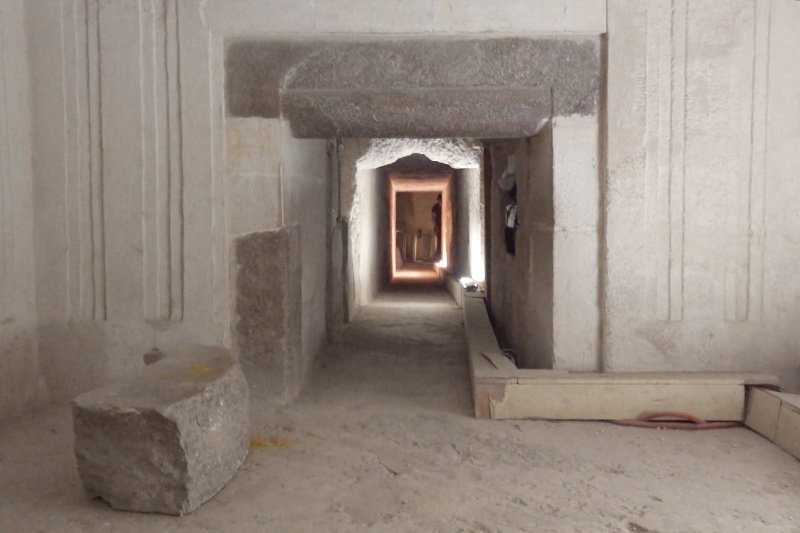
Pyramid of Menkaure 3D Scanning Project - WORLD SCAN PROJECT’s Challenge
Standing tall in the desert of Giza are the great pyramids of Khufu, Khafre, and Menkaure, symbols of the Old Kingdom's prosperity, power, and divinity. Among these royal tombs, the Pyramid of Menkaure was the last to be built.
The World Scan Project (W.S.P) team collaborated with Dr. Yukinori Kawae, an Egyptologist at Nagoya University and an Emerging Explorer of the National Geographic Society, to conduct a joint survey of Menkaure's Pyramid.
The Pyramid of Menkaure
This pyramid was built around the 26th century BC by Menkaure, a pharaoh of the 4th dynasty of ancient Egypt. Known as "Netjeri Menkaure", meaning "Menkaure is Divine", it was also called the "Red Pyramid" in the Middle Ages because a third of its surface was covered with red granite.

Compared to the pyramids of Kings Khufu and Khafre, King Menkaure's pyramid is smaller in scale, with a height of about 65 meters, a base area of about one-fourth, and a total stone weight of about one-tenth that of Khufu's pyramid. There are various theories as to the reason for this reduction, including a weakening of royal authority, financial constraints, and a lack of land.
Typically, a pyramid is part of a larger complex that includes funerary temples, causeways, and valley temples. However, Menkaure's complex remains unfinished due to the king's sudden death.

The gash from the failed medieval demolition
The Pyramid of Menkaure, while the smallest of the Great Pyramids of Giza, is a crucial clue to understanding how these pyramids were constructed.
This clue lies in a gash in the north side of the pyramid. This gash was originally dug in the 12th century under Islamic rule with the intention of dismantling the pyramid or gaining access to its interior. In the 19th century, British military officer Howard Vyse used dynamite in an attempt to find the entrance to the pyramid, resulting in the shape we see today.

Although it was an act of violence against a historical artifact, the destruction exposed the internal structure and revealed the core construction of the pyramid, including the stair-like arrangement of stones that contribute to its stability.

And this time, the World Scan Project (W.S.P) successfully obtained a special permit to investigate the other side of that gash. Using data obtained through 3D scanning, the project is delving into the analysis of the pyramid's interior in an effort to unravel the mysteries of its construction.

Inside the Pyramid of Menkaure
The entrance to the pyramid, which was spared from destruction, is 4 meters above the ground. As you proceed through the passage, you enter a room decorated with what is known as the "palace facade," a style of undulating wall decorations. Unlike the pyramids of Kings Khufu and Khafre, this distinctive decoration features walls with a palace motif, suggesting that the pyramid served not only as a tomb, but as an eternal dwelling.

The antechamber was originally intended to be the burial chamber of King Menkaure. However, the presence of construction work for a burial chamber beneath the antechamber indicates that the plan was changed for some reason. This suggests that the ancient Egyptians did not strictly follow their original plans, but rather developed the pyramid through a process of trial and error.

Particularly intriguing is the presence of a "Relieving Chambers" inside King Menkaure's pyramid, a feature also found in King Khufu's pyramid. This architectural technique, which creates a space above the ceiling of the burial chamber to prevent it from being crushed under the weight of the pyramid, highlights the advanced engineering skills of the ancient Egyptians.

Descending from the antechamber you reach the granite burial chamber of King Menkaure. At the time of its discovery, a sarcophagus was found inside, but it was lost at sea when the ship transporting it to the British Museum in London sank. Therefore, whether the remains that once rested in the burial chamber belonged to King Menkaure remains an enduring mystery.

Making the world, the future, and curiosity closer
The Pyramid of King Menkaure stands as a testament to the ingenuity of ancient Egyptian architecture, offering invaluable insight into the construction techniques of a bygone era. At the World Scan Project, we are deeply committed to conducting 3D scanning surveys of Egyptian ruins, including this monumental pyramid.
By preserving the site as digitally recorded data, we can continue to pass on ancient knowledge and splendor to future generations, even if the site is damaged or lost to destruction over time. Passing the baton of history from the ancient to the modern and into the future through digital technology is our goal. We invite you to follow the activities of the World Scan Project and join us on our journey.
Please also check out this video about Pyramid of Menkaure.
この記事が気に入ったらサポートをしてみませんか?
